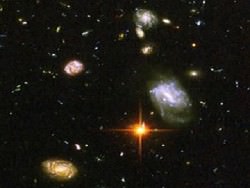The evidence that the Universe began with the Big Bang is very compelling. 13.8 billion years ago, the entire Universe was compressed into a microscopic singularity that grew exponentially into the vast cosmos we see today. But what does the future hold? How will the Universe end?
Astronomers have been pondering the ultimate fate of the Universe for thousands of years. In the last century, cosmologists considered three outcomes for the end of everything, and it all depended on the critical density of the Universe. If this critical density was high, then there was enough mutual gravity to slow and eventually halt the expansion. Billions of years in the future, it would then collapse in on itself again, perhaps creating another Big Bang. This is known as a closed Universe, and the final result is the Big Crunch.
If the critical density was low, then there wouldn’t be enough gravity to hold things together. Expansion would continue on forever and ever. Stars would die, galaxies would be spread apart, and everything would cool down to the background temperature of the Universe. This is an open Universe, and the end is known as the Big Freeze.
And if the critical density was just right, the Universe’s expansion goes on forever, but it’s always slowing down, reaching a dead stop in an infinite amount of time. This creates a Flat Universe… also a Big Freeze.
Fortunately, astronomers were able to measure the critical density of the Universe, using NASA’s WMAP spacecraft, and they discovered that the actual density of the Universe predicts a flat Universe. So that’s it, right? Of the three choices, the answer is #3.
Unfortunately, nature had other plans, and came up with a reality that nobody expected. In 1998, a team of astronomers were observing distant supernovae to get a sense of how fast the Universe is slowing down and they made an amazing discovery. Instead of decelerating, as predicted by the critical density of the Universe, the expansion of the Universe is actually speeding up.
Some mysterious force is pushing galaxies faster and faster away from each other, accelerating the expansion of the Universe. We now call this force “dark energy”, and for the time being, astronomers have no idea what it is. All we know is that it’s pushing the Universe apart. Distant galaxies are being accelerated away from us, and in trillions of years from now, they will cross the beyond the cosmic horizon and disappear from view. The evidence that we live in a vast Universe will disappear with them.

But there’s a further unsettling possibility about dark energy. Maybe the expansion pressure will increase, eventually overwhelming gravity on a local level. Galaxies will get torn apart, and then Solar Systems, and eventually atoms themselves will be shredded by the increasing dark energy – this idea is known as the Big Rip.
So how will the Universe end? The force of dark energy will continue to accelerate the expansion of the Universe until distant galaxies disappear. Galaxies will use up all the gas and dust for stars and go dark, perhaps becoming black holes. Those black holes will decay and maybe matter itself will decay into pure energy. The entire Universe will become a cold, quiet place, where single photons are stretched across light years of space.
Don’t worry, though, that won’t be for quadrillions of years from now.

